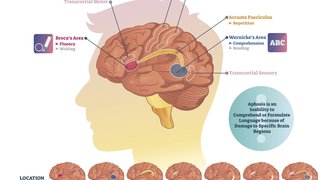
You don’t need the flux capacitor from “Back to the Future” to see how far Parkinson’s disease care has come since actor Michael J. Fox went public with his diagnosis in 1998. His new documentary, “Still,” is shining a fresh spotlight on the challenges of living with PD, as well as progress being made in research, early diagnosis, and effective treatment of symptoms.
Mr. Fox was diagnosed when he was 29. The average age of diagnosis is 60. However, he has played a pivotal role in raising awareness of the condition and mobilizing fundraising for research – more than $1.5 billion through the Michael J. Fox Foundation.
On Sept. 24, 2024, former NFL quarterback and Pro Football Hall of Famer Brett Favre revealed in a congressional hearing that he has been diagnosed with Parkinson's. Favre, who played 20 seasons in the NFL, has said that he sustained over 1,000 concussions during his playing career.
PD requires a team approach to manage the motor, cognitive, and other non-movement-related symptoms that patients face. And because it affects each person a little differently, UT Southwestern specialists in neurology and movement disorders work closely with psychiatry, psychology, and therapy (including physical, occupational, and speech) to develop a personalized plan for each patient’s physical and mental health needs and long-term lifestyle goals.
Receiving a Parkinson’s diagnosis can be heavy and overwhelming. We will talk you through what is currently happening in your brain and body, what may come, and how we can work together to manage symptoms and help reach your care goals.
As Fox says, “Parkinson's patients are the experts on what we have,” and that’s very true. Ultimately, you are the most important person on the care team. Investing time and energy into your physical and mental health – especially through exercise and taking medications properly – is key to living a full life with PD.
A primer on Parkinson’s disease
PD is a degenerative disorder of the nervous system that causes people to gradually lose control over movement. It is the second most common neurodegenerative condition and affects about 1% of the population over age 65.
Fast Facts
* 60,000 people are diagnosed with Parkinson's disease annually.
* Age 60 and older is when Parkinson’s typically develops.
* 20% of people have mild cognitive impairment at the time of diagnosis.
* There is no cure for Parkinson's, but there are effective treatment strategies to manage its symptoms.
PD symptoms result from a loss of dopamine-producing cells; dopamine is a neurotransmitter that sends signals in the brain and is vital to many bodily functions, including movement, mood, behavior, and sleep. People with Parkinson’s often are found to have deposits of a misfolded protein known as alpha-synuclein in the nerve cells that generate dopamine. Protein misfolding, in which a protein becomes corrupted and changes shape, causes toxicities that result in cell death.
While genetics and exposure to certain toxins and environmental factors appear to increase a person’s risk, the cause of Parkinson’s disease is not well understood.
PD is best known for causing tremors, muscle stiffness, and impaired gait/balance that can lead to falls. But it also can cause non-motor symptoms including sleep problems, speech changes, urinary issues, constipation, mood changes, depression, anxiety and changes in cognitive function, including problems with memory, attention, and the ability to plan and accomplish tasks.
Non-motor symptoms of PD such as loss of sense of smell, acting out dreams, and constipation can predate onset of motor symptoms by a decade. In “Still,” Mr. Fox describes the subtle finger twitch (or tremor, a motor symptom) that could be an early symptom of Parkinson’s.
A friend or family member may be the first to notice changes, and some patients find out when they see a specialist for a non-specific symptom. For example, they may see an orthopedic doctor for trouble with arm movement or a psychologist for depression.
There are five typical stages of Parkinson’s disease, which may progress slower in young patients and faster in older patients:
- Stage 1: Mild symptoms such as tremor occur on one side of the body. Symptoms generally do not interfere with daily activities.
- Stage 2: Symptoms such as tremors, stiffness, and slowness affect both sides of the body and make daily tasks more difficult.
- Stage 3: Loss of balance and falling increases and daily activities are restricted, though some patients still live independently.
- Stage 4: Symptoms become severely disabling and patients need help for daily living. A cane or walker may be needed for mobility.
- Stage 5: Advanced stage; patients cannot stand or walk and need a wheelchair. Help is required for all activities.
Not all patients will have every symptom of PD, and progression varies. While there is currently no cure for Parkinson’s, there are treatments to manage its symptoms. Your treatment plan will be based on how PD affects you.
Physical care for Parkinson’s disease
Medication is generally the first step in treatment, and levodopa (L-DOPA) is currently the most effective PD drug.
The brain converts L-DOPA into dopamine, helping to improve motor symptoms including slowness, stiffness, and tremors. There are different formulations of L-DOPA including tablets, capsules, and intestinal gel, which is delivered by a portable pump continuously over 16 hours.
Other common medications include DA agonists that activate the brain’s dopamine receptors, COMT inhibitors, and MAO-B inhibitors that extend the effects of L-DOPA. To get the maximum benefit, clinicians work with each patient and come up with right medication regimen with specific instructions such as time of intake, taking them on an empty stomach or with a full glass of water.
UTSW specialists are also experts in advanced treatment options such as:
- Botulinum toxin (Botox) injections to relax muscle spasms and help control dystonia, which involves cramping movements of the limbs or neck, eye twitching, and drooling. Treatments typically are effective for three months, so injections are repeated several times a year to maintain ongoing benefits.
- Deep brain stimulation (DBS), a procedure to implant electrodes into a specific part of the brain to reduce motor symptoms. Some DBS batteries can last for a decade or more, and with advanced techniques from our expert neurosurgeons, the electrodes can be placed in precisely the right spot of the brain to manage symptoms.
- High-intensity focused ultrasound, a noninvasive MRI-guided procedure that uses ultrasound waves to heat and destroy brain cells in a small area of the brain region that contributes to tremors.
Parkinson’s disease can cause sleep disorders such as vivid nightmares, restless legs syndrome, REM sleep behavior disorder (RBD), and periodic limb movement disorder (PLMD). Lack of sleep can cause or increase problems with concentration, energy, or depression. Medication and practicing good sleep hygiene can help with these symptoms.
Exercise and physical therapy play a key role in treating PD symptoms. UTSW specialists often recommend BIG training, a type of physical therapy that helps patients learn to produce more natural movements with extra effort and “recalibrate” how they perceive motion compared with what people around them see.
Special exercise programs geared toward Parkinson’s can increase mobility, strength, and balance and help you remain independent. Your doctor will talk with you about the programs or exercises that may help, such as riding a stationary bike and Rock Steady Boxing, which is specially designed for patients with PD and involves non-contact boxing workouts.
Managing Parkinson’s symptoms is a lot of work. However, feeling better day to day is a worthwhile tradeoff for prioritizing good sleep and exercise in your daily routine.

Parkinson's resources and support
Here are some local and national resources we often recommend:
Parkinson & Movement Disorder Alliance, NE Texas/Dallas-Fort Worth
Mental and cognitive care
About 20% of people have mild cognitive impairment at the time of diagnosis, which is slightly higher than the general population rate of 16-20%. Symptoms such as depression and anxiety often occur before obvious motor symptoms, and a psychiatrist may suspect Parkinson’s before the person has even seen a neurologist.
The American Parkinson Disease Association recommends doing mental “exercise” such as completing puzzles, reading, talking with friends, and going to concerts or lectures to help improve and retain cognition. Neurorehabilitation such as occupational therapy and speech therapy can help regain, retain, and incorporate physical and cognitive exercises.
Along with cognitive and mood changes caused by dopamine loss, many patients also feel anxious, depressed, and frustrated at times. Psychiatrists and psychotherapists can help patients and families work through the emotional challenges of living with PD with effective therapies, such as Acceptance and Commitment Therapy (ACT). This form of behavioral therapy encourages people to embrace their thoughts and feelings rather than fighting or feeling guilty about them. It also combines mindfulness skills with setting realistic goals for how a person wants to live. There may also be a role for pharmacotherapy in the treatment of neuropsychiatric symptoms like depression and anxiety.
Patient education and support groups are instrumental in helping patients and families adjust to living with PD.
The future of Parkinson's care
UT Southwestern movement disorders specialists in the Peter O’Donnell Jr. Brain Institute have a national reputation for advancing PD care and research. We are currently enrolling in research studies for Parkinson's disease to understand motor physiology and brain networks as well as essential tremor.
While current science cannot prevent or cure PD, research is quickly advancing our knowledge to improve detection of early symptoms, make a faster diagnosis, and manage symptoms to help preserve patients’ quality of life.
Early PD detection is a research area of great interest. In April 2023, scientists announced the discovery of a new test that can detect abnormal alpha-synuclein in a person’s spinal fluid with great accuracy – 93% of patients with PD in the study were found to have abnormal alpha-synuclien, which was previously detectable only through autopsy. This breakthrough could lead to earlier and more accurate diagnosis of patients with PD symptoms and identification of those at high risk of developing PD. It also may accelerate the development of more advanced treatments, such as stem cell and gene therapies and immunotherapy.
Researchers also recently shared encouraging results from a multicenter NIH study showing that a skin biopsy could detect PD. The test is very accurate – better than 95% sensitivity levels – and identifies an abnormal or misfolded protein in the skin, alpha-synuclein, which is a strong indicator of Parkinson’s and related disorders.
In the words of Michael J. Fox, “Acceptance doesn’t mean resignation. It means understanding that something is what it is and there’s got to be a way through it.” UTSW is committed to treating, guiding, and empowering patients and families living with PD. You are more than any diagnosis. You have a fulfilling life to live, and you are not on this journey alone.
To talk with a specialist about Parkinson’s disease, call 214-645-8300 or request an appointment online.












